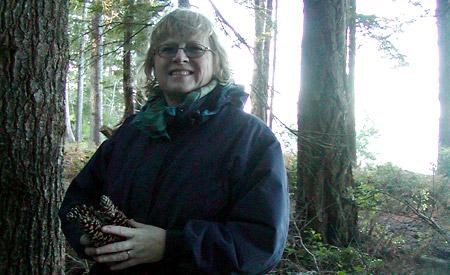A Savary Island land trust has reached the halfway goal in raising funds to preserve a 2.5-acre parcel that contains a rare forest.
Savary Island Land Trust Society (SILTS) hopes to raise $265,000, half of the value of eight undeveloped lots that contain a forest with red cedar, Douglas fir, arbutus, western white pine, shore pine, hemlock, red huckleberry and salal. Owners of the property, the Johnson family from Calgary, Alberta, are donating four of the eight lots to SILTS.
Dr. Ernest A. Johnson and his wife Edna acquired the property in 1964. Johnson, who was known as The Flying Doctor, was a well-known surgeon and teacher who was awarded the Order of Canada for his international work in eye care.
At the time her parents bought the property, said Judy Johnson, there was a landing strip on the island that enabled easy access. “Over the years the landing strip was closed and due to his demanding lifestyle, there were fewer visits to the property,” she explained. “From time to time Ernie and his son David visited the island and were always impressed by the hospitality and easy going attitude of its inhabitants and the beauty of their surroundings.”
After Ernie died in 2005, the family decided that the eight lots should be kept intact as a greenspace. Judy and David visited the island on a couple of occasions and talked with Liz Webster, executive director of SILTS, regarding the possibility of donating four of the lots and SILTS acquiring the other four lots to protect them from further development. “Savary is a small island and home to several species of flora and fauna that are of ecological significance,” Judy said. “If this island were to continue to populate, the integrity of its resources and all those elements that contribute to its uniqueness would be in jeopardy. All the islanders have assumed this responsibility and are vigilant in their efforts to preserve the fragile ecosystem of Savary.” The property is being donated under Environment Canada’s Ecological Gifts Program.
Savary was over-subdivided into more than 1,700 parcels around 1910, said Webster. “This is the highest density of subdivision in the Salish Sea,” she said. “Essentially it is a rare forest that was chopped up into city-size lots a century ago. The Johnson Forest represents a rare opportunity to protect a 2.5-acre parcel of forest and undo some of the century-old land use legacy of over-subdivision.”
Savary lies at the northern edge of the Coastal Douglas-fir (CDF) biogeoclimatic zone of British Columbia. It represents a highly unusual landscape within the CDF, which is the most threatened biogeoclimatic zone in the province. Almost 50 per cent of the CDF zone has been converted to non-reversible land uses and the remaining ecosystems within the zone are highly fragmented, due to subdivision and development. Only a few large contiguous patches of forested and non-forested ecosystems remain. “This is even more critical for the land parcels on Savary, as the ability to maintain large, contiguous patches on islands is of greater significance,” said Webster.
Savary’s flora and fauna are quite different from other rocky islands in the Strait of Georgia and include a number of red-listed species. The unique geology and ecology makes Savary extremely rare, fragile and endangered.
When SILTS began in 1997, there was no protected land on Savary. Currently, there are over 200 acres protected by the Nature Trust of BC, the province and SILTS. SILTS currently holds 11 parcels (over 14 acres), which have been donated by islanders.
A pledge for $100,000 kicked off the campaign to raise the $265,000 for the Johnson Forest. More pledges, donations and contributions from a fundraiser in the summer, Savarystock, boosted the total to $127,300. The society still needs to raise $137,700.
Interested readers can find more information about SILTS and the Johnson Forest on SILTS' website, as well as make a donation. Webster points out that each $50 donation buys one square metre of the Johnson Forest.



